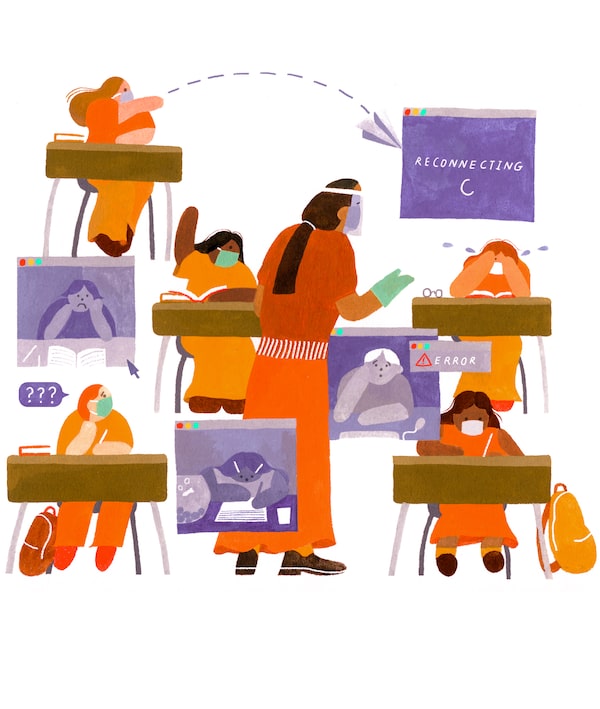
Illustration by Mary Kirkpatrick
First Person is a daily personal piece submitted by readers. Have a story to tell? See our guidelines at tgam.ca/essayguide.
“Madame! I am so confused!”
The little boy in Row 2 stares at me through his round Harry Potter-style glasses, eyes wide, bewilderment written all over his face. I’m not sure if the French words on the board are causing his confusion or the “new normal” of school in a pandemic, so I try to reassure him.
From a safe two-metre distance, I look at him through the glare of my face shield and send him an encouraging smile hidden by the mandatory mask, my sweaty hand in blue plastic gloves tentatively reaching out to comfort him.
“Ca va bien aller,” I utter without much conviction. “It’s going to be all right!”
Muffled by fabric and vinyl layers, the French words are even less comprehensible to the confused child sitting in front of me.
Behind all the PPE, I agree silently: I’m confused, too. And no, nothing is all right!
Welcome to my Grade 1 French Immersion classroom. One of the thousands of elementary classrooms in Ontario that reopened their doors in September to more than one million students in the province to offer face-to-face learning. One-third of these students chose online learning in September, and their number is growing every day – a never-ending exodus of students to the virtual world of learning.
My class list started with 23 six-year-olds, but after four weeks became an intimate group of 12 learners in the room. Eight of them then opted for the virtual classroom; three more students left within the first four weeks of COVID-19 school.
And what a month it was.
Week 1
Empty classrooms wait patiently for the arrival of yet another year of children ready to learn (or not). Shiny waxed floors, pristine whiteboards and polished desks neatly arranged precisely one metre apart. There isn’t more room for distance than that.
Gone are carpets and bookshelves, computer stations and listening centres – everything that makes an elementary classroom, especially in Grade 1, so unique. Learning in a safe environment just took us back 100 years in time. “I miss the old school!” the boy in Row 2 said to me the other day. I know exactly what he means.
We spend Week 1 learning how to line up with your arms stretched out (Garde la distance!), sanitizing hands when coming in (Du gel!), sanitizing when going out (Du gel!), walking on the right side (A la droite!), staying at your seat (Reste a ta place!) and washing hands (Lave les mains!).
Don’t talk!
Don’t touch!
Wear your mask!
Breathe (as much as that’s possible through a mask)!
Lately, I feel more and more like a drill sergeant than an educator.
Week 2
Masks. Reusable masks with superheroes and cartoon figures on them. Paper masks with pink unicorns and cute little koalas. Smiling masks and scary ones. Masks in black and grey and pink.
Full of hope and enthusiasm, we had decorated paper bags to keep each mask safe and clean on the first day of school. By Week 2, most of these bags have ripped or disappeared into the endless abyss of the students’ desks. Masks are anywhere but safe and clean: on the floor, under chairs, in the hallway, in the yard. They hang off children’s chins or dangle around their necks. They’ve learned a mask makes for a great slingshot – it’s astounding how far these things can fly, especially when soaked in a day’s worth of spittle. One of my students pulls down his mask every time he sneezes – he doesn’t want to get his mask all wet and nasty. I get it – there is nothing worse than the smell of a moist and stale breath inside that thing.
Week 3
Now, there is an added layer of safety to teaching: The face shield is declared mandatory for all teachers in my area in addition to wearing a mask.
Learning a new language is difficult enough for a Grade 1 student. With my mouth and most of my face covered by a mask and the sound of my voice muffled by the added plastic barrier, understanding and repeating what I say in French becomes very difficult for my students.
“Bonjour mes amis!” I articulate as clearly as possible.
“Monmour me mami!” they repeat.
I am beginning to sound like unintelligible Miss Othmar in the Charlie Brown comics.
“Wah wah woh wah wah!”
At least I can blame it on COVID-19 if my students’ language skills do not progress as they should.
Week 4
“Playdates are cancelled! Thanksgiving cancelled! And so is Christmas!”
Horror is written all over their partly visibly little faces, my class is listening to a classmate announcing what sounds like the end of the world.
“Well, not really!” I try to calm down my students who are now verging on hysteria. “There is still so much to be grateful for!” I explain lamely. “And there definitely will be Christmas – just different.”
What is getting cancelled are the virtual classrooms. Remote learning is still a thing and so is in-class instruction. But now both will be done by one teacher instead of two: me! Give it a fancy name and call it “hybrid learning.”
I won’t even have digested my turkey dinner when my class will have doubled in size, with half of the group sitting in front of me and the other half joining us online via Google Meet. Watching every step I make, every breath I try to take, every muffled French sound I make. “Wah wah woh wah wah!”
“I am so confused, Madame!”
“So am I, my friend. So am I. Welcome to the land of confusion.”
Gisela Koehl lives in Thornhill, Ont.